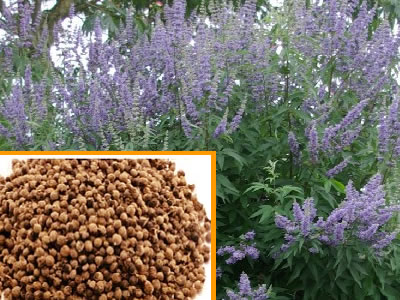Chasteberry has been used for thousands of years as ‘women’s herb’ to treat menstrual cramps, premenstrual syndrome (PMS), menopause, and increase breast milk.
Chasteberry (Chaste berry, Chaste tree berry, Vitex, Monk’s pepper) is the fruit of the chaste tree. Chasteberry is used as a hormonal tonic for women to alleviate symptoms of the gynecological problems. It has been used for thousands of years for women to ease menstrual problems and stimulate the production of breast milk. Chasteberry regulates the balance of estrogen and progesterone in the body by stimulating and normalizing the pituitary gland.
Scientific Studies about Chasteberry
Clinical studies have demonstrated the effects of chasteberry in the management of premenstrual stress syndrome (PMS) and cyclical breast pain (mastalgia). A study has shown that extracts of the fruit of chasteberry can bind to opiate receptors, and reduce PMS discomforts. Today, there are good evidence supporting at least the following uses: Premenstrual Syndrome (PMS), Cyclical mastalgia, Mild hyperprolactinemia, and Luteal phase defect.
Scientists still do not know the exact mechanism of action, but assume that chasteberry may have dopaminergic effects resulting in changes of prolactin secretion. Researchers found that vitex at low doses inhibits activation of dopamine 2 receptor by competitive binding, slight increasing the release of prolactin. In higher concentrations modern extracts, the binding activity sufficiently reduces the release of prolactin. Scientists assume that dopaminergic compounds in vitex is likely to improve premenstrual mastodynia and possibly also psycho-somatic symptoms of PMS.
Researchers have found many chemical compounds in vitex agnus-castus, such as flavonoids, alkaloids, diterpenoids, vitexin, casticin and steroidal hormone precursors. They believe that some of these compounds work on the pituitary gland, thus have effects on hormonal levels.
Chasteberry can be used to make a decoction, tincture or syrup. The berries can be simply eaten as food. Chasteberry is sold in forms of capsules and extracts. You may find it in a health supplement store.
How to make chasteberry decoction
– Dried berries 1-2 teaspoons (or a handful of fresh berries)
– Water 1 cup
– Boil and simmer the berries for 15 minutes
– Drink it 2-3 times a day
How to make chasteberry tincture
– Fresh berries 500g (or dried berries 100g)
– Alcohol 55%-85% (vodka or other grain alcohol) 1000ml
– Put the berries and alcohol in a glass jar
– Tighten the cap
– Leave it for one month or longer
– Strain and store the liquid in bottles
– Drink it 20ml, once or twice a day
The effects and chasteberry is mild. It may take several months to see the improvement.
Please note, though chasteberry has not been associated with serious side effects, but before you use it, you should consult a health care provider.
Read more information about natural remedies for menstruation.



